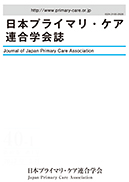Volume 43, Issue 4
Displaying 1-15 of 15 articles from this issue
- |<
- <
- 1
- >
- >|
-
2020Volume 43Issue 4 Pages 115
Published: December 20, 2020
Released on J-STAGE: December 29, 2020
Download PDF (110K)
-
2020Volume 43Issue 4 Pages 116-122
Published: December 20, 2020
Released on J-STAGE: December 29, 2020
Download PDF (403K) -
2020Volume 43Issue 4 Pages 123-128
Published: December 20, 2020
Released on J-STAGE: December 29, 2020
Download PDF (347K) -
2020Volume 43Issue 4 Pages 129-137
Published: December 20, 2020
Released on J-STAGE: December 29, 2020
Download PDF (389K)
-
2020Volume 43Issue 4 Pages 138-141
Published: December 20, 2020
Released on J-STAGE: December 29, 2020
Download PDF (297K) -
2020Volume 43Issue 4 Pages 142-144
Published: December 20, 2020
Released on J-STAGE: December 29, 2020
Download PDF (440K)
-
2020Volume 43Issue 4 Pages 145-147
Published: December 20, 2020
Released on J-STAGE: December 29, 2020
Download PDF (239K) -
2020Volume 43Issue 4 Pages 148-150
Published: December 20, 2020
Released on J-STAGE: December 29, 2020
Download PDF (426K)
-
2020Volume 43Issue 4 Pages 151-154
Published: December 20, 2020
Released on J-STAGE: December 29, 2020
Download PDF (298K)
-
2020Volume 43Issue 4 Pages 155-157
Published: December 20, 2020
Released on J-STAGE: December 29, 2020
Download PDF (330K)
-
2020Volume 43Issue 4 Pages 158-160
Published: December 20, 2020
Released on J-STAGE: December 29, 2020
Download PDF (351K)
-
2020Volume 43Issue 4 Pages 161-162
Published: December 20, 2020
Released on J-STAGE: December 29, 2020
Download PDF (122K)
-
2020Volume 43Issue 4 Pages 163-165
Published: December 20, 2020
Released on J-STAGE: December 29, 2020
Download PDF (160K)
-
2020Volume 43Issue 4 Pages 166
Published: December 20, 2020
Released on J-STAGE: December 29, 2020
Download PDF (92K)
-
2020Volume 43Issue 4 Pages 167-168
Published: December 20, 2020
Released on J-STAGE: December 29, 2020
Download PDF (209K)
- |<
- <
- 1
- >
- >|
